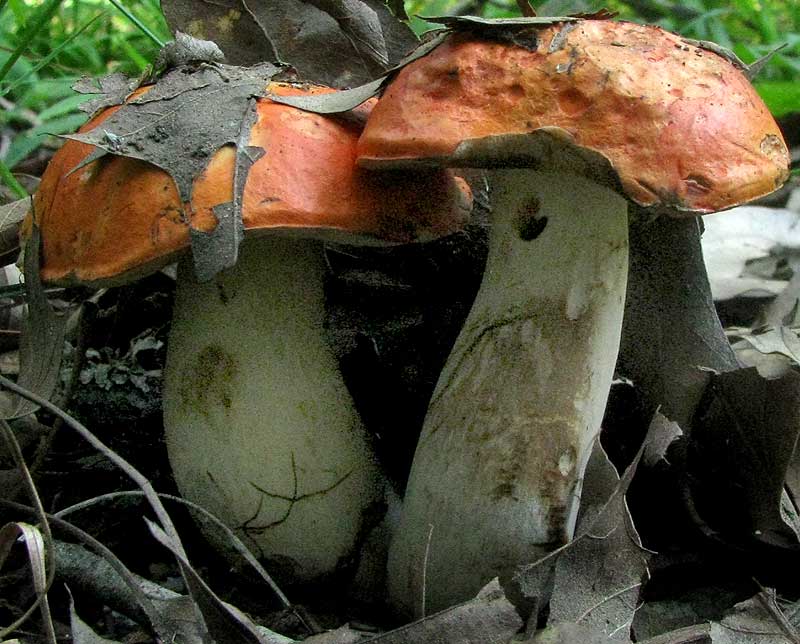Excerpts from Jim Conrad's
Naturalist Newsletter

from the May 27, 2012 Newsletter issued from the woods of the Loess Hill Region a few miles east of Natchez, Mississippi, USA
A RED-CAPPED "BOLETE"
From the much-shaded, moist, leaf-littered ground next to my trailer arose a pair of red-capped mushrooms with thick, white, brown-staining stems, as shown above. Recognizing the general form as typical of the delicious bolete mushrooms of which I've picked and eaten so many in Europe, I tipped over a cap to see if it was gilled or pored, for boletes are among that minority of mushrooms who bear pores, not gills. You can see what I saw below:

Pores! So it was a bolete. You can see what a bolete cap with pores instead of gills looks like in cross section below:

There you can see that the pores are the bottom openings of long, vertical tubes. Spores form inside those tubes and fall out of the openings at the bottom, which appear as pores.
So, our mushroom is a bolete and boletes are famous for good eating. However, recalling my 2006 mushroom poisoning (described at the bottom of the page at https://www.backyardnature.net/n/x/green-sp.htm) and not willing to assume that American boletes are as uniformly edible as European ones, I wanted to know what species this was.
To many the term bolete means a member of the genus Boletus. It looks like the mushroom in our pictures is XANTHOCONIUM PURPUREUM, so it's debatable as to whether it's a real bolete. It's a member of the Bolete Family, the Boletaceae. However, no genetic studies support the existence of the genus Xanthoconium, plus, back in the days before genetic sequencing, Xanthoconium purpureum mushrooms appear to have been overlooked, even though in many places, including here, they're quite common. They were assumed to be variations of various Boletus species. All this goes to show that especially among the fungi the identities of even common things often are uncertain, or unknown, even by the experts. Neither Phillips's Mushrooms of North America, claiming to be "the most comprehensive mushroom guide ever," nor Simon & Schuster's Guide to Mushrooms, mentions the genus Xanthoconium, much less our species.
Features taking me to Xanthoconium purpureum include the fact that the cap didn't bruise green or blue as many boletes do, but only slightly brown. The flesh and pore surface was white and the cap when young was bright red but with age turned reddish tan. Spore color was yellow-brown. Also, MushroomExpert.com's Michael Kuo makes the point that often malformed, contorted individuals of this species are encountered, prominent among these being mushrooms with grossly oversized stems -- such as the one shown below:

That one appeared about a week after the first pictures were taken, and in the same place -- apparently from the same mycelium.
Michael Kuo also says that at spore-producing time Xanthoconium purpureum produces a "somewhat foul and bad-meat-ish odor." That's like ours, too. This is one "bolete" I'm not eating.